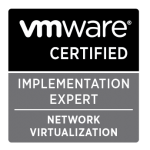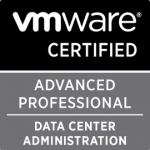This post is also available in: Italian
Reading Time: 4 minutesAs written in a previous post, it’s possible study for the VCP-NV exam using only on-line resources, but the same it’s not really possible for the Network Certified Implementation Expert (VCIX-NV) certification that require really a good practice with the interface and a well understand of all NSX concepts. This exam is available since October 2014.
As usual, the first source of information is the Exam Blueprint (actually in version 1.7, dated 9 December 2014) that give you a lot of information about the exam and also the environment (note that actually there isn’t a simulator or a demo or a mock).
The virtual environment consisting of a management cluster, multiple compute clusters, and related virtual machines. The lab environment is based on vSphere 5.5 and NSX for vSphere 6.0.2.
 The VCIX-NV Exam consists of 18 live lab activities and a short pre-exam survey consisting of 9 questions. Live lab activities consist of multiple tasks, where each task is scored. The total number of activities provided is based on the total number of tasks. Because of this, the actual number of lab activities may vary slightly between exams.
The VCIX-NV Exam consists of 18 live lab activities and a short pre-exam survey consisting of 9 questions. Live lab activities consist of multiple tasks, where each task is scored. The total number of activities provided is based on the total number of tasks. Because of this, the actual number of lab activities may vary slightly between exams.
As each live exam remember that there can be some issue in latency (see also this post), connections, and more important TIMING… be sure to arrive at least 15 minutes before the exam start!
VMware Hands on Labs may help, but for this exam you really need your own lab to make much practice as possible. Anyway labs like HOL-SDC-1425 – VMware NSX Advanced are still pretty useful, remember only (for the exam preparation) to focus only on 6.0.x features (so not the DHCP relay or the ECMP features covered in this lab).
VCIX-NV exam experience
Several people have already passed this exam and can provide their point of view:
- My experience with VCIX-NV exam
- Frank Buechsel
- Tom Fojta (the first double VCDX)
- Ross Wynne
VCIX-NV Blueprint with notes
There are several blueprint resources
- http://blog.jgriffiths.org/?p=1031 (only objective 1.2)
- http://www.definit.co.uk/vcix-nv-exam-preparation/ (only objective 1.1)
- http://www.routetocloud.com/certifications/vcix-nv/ (most objectives)
- http://lostdomain.org/vcix-nv-study-guide/ (all objectives and really well done)
- The (Un)official VMware VCIX-NV Study Guide (available also as a PDF file)
But actually just the last one is really complete with all the sections and the objectives (anyway there are also a lot of good post also on the third resource):
Section 1 – Install and Upgrade VMware NSX
- Objective 1.1 – Deploy VMware NSX Components
- Objective 1.2 – Upgrade VMware NSX Components
- Objective 1.3 – Configure and Manage Transport Zones
Section 2 – Create and Manage VMware NSX Virtual Networks
- Objective 2.1 – Create and Administer Logical Switches
- Objective 2.2 – Configure VXLANs
- Objective 2.3 – Configure and Manage Layer 2 Bridging
- Objective 2.4 – Configure and Manage Logical Routers
Section 3 – Deploy and Manage NSX Network Services
- Objective 3.1 – Configure and Manage Logical Load Balancing
- Objective 3.2 – Configure and Manage Logical Virtual Private Networks (VPNs)
- Objective 3.3 – Configure and Manage DHCP/DNS/NAT
Section 4 – Perform Operational Maintenance
- Objective 4.1 – Backup and Restore Network Configurations
- Objective 4.2 – Monitor an NSX Implementation
Section 5 – Perform Advanced Troubleshooting
Objective 5.1 – Troubleshoot Common NSX Installation/Configuration Issues
Objective 5.2 – Troubleshoot Common NSX Component Issues
Objective 5.3 – Troubleshoot Common Connectivity Issues
Objective 5.4 – Troubleshoot Common Services Issues
Section 6 – Secure an NSX Environment
- Objective 6.1 – Configure and Administer Firewall Services
- Objective 6.2 – Configure and Administer Role Based Access Control
- Objective 6.3 – Configure and Manage Service Composer
Section 7 – Utilize API and CLI Commands to Manage an NSX Deployment
- Objective 7.1 – Administer and Execute calls using the NSX vSphere API
- Objective 7.2 – Manage and Report on an NSX Environment using the NSX Command Line Interface
NSX Troubleshooting
This part is absolutely not coverd by the Install & Configuration course and could be quite difficult. On Internet there are a lot of resource pages, but most of them are really minimal or just copy of each other.
Anyway you can start from:
NSX API
Also this part is absolutely not coverd by the Install & Configuration course and could be quite difficult.
You can start from:
Additional resources
Other hints for this exam:




